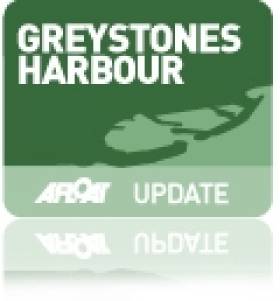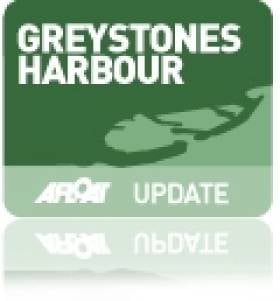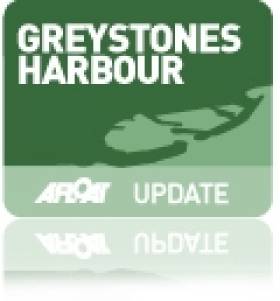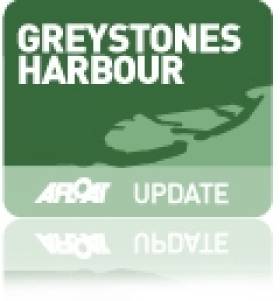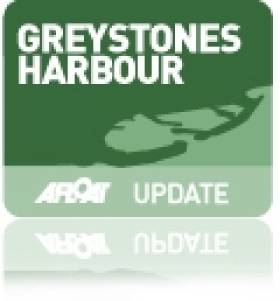Displaying items by tag: Greystones
Council Bond Ensures Greystones Harbour will Open - Councillor
Wicklow Councillor Derek Mitchell has moved to reassure frustrated boaters and townspeople alike that the partially completed €300 million Greystones Harbour and Marina will be completed. In a letter to the Irish Times this morning the councillor acknowledges that the delays are 'frustrating' but advises the council holds a €5 million bond to ensure the project will be completed.
A recent survey of prospective boat owners found 80% of berths required in the proposed 200 berth marina would be under eight mertres. Mitchell admitted earlier this year more interest from boat owners was required to get the marina underway.
The council bond is not exercisable until 2014.
A slipway at the community harbour is operational but the public square and five free clubhouses for different boating activities from angling to sailing are still to be provided. Last November builders Sispar held an open day to show off the impressive marine works.
A spokesperson for development consortium Sispar previously advised the decision on funding the next phase rests with that National Assets Management Agency (Nama).
More Interest Required to Open Greystones Marina
There was good news in Wicklow for watersports fans with the opening of the new public slip at Greystones harbour last August but there was disappointing news from Cllr Derek Mitchell yesterday who conceded that"currently not enough boat owners have expressed interest in paying for berths in the planned marina. This could mean completion of the 220 berth marina could be delayed beyond 2011.
Last October concern was raised over the Euro 300 Million redevelopment of the harbour after the builders confirmed the project is to come under the control of Nama.
Currently the breakwater is complete but there is no marina furniture installed.
In an update on his website yesterday Cllr Mitchell believes that more boat owners are interested but they need to be contacted again.
It is expected through that over 80% of berths required are for boats under six metres, such as small local fishing craft.
The new public slipway however is open and it is possible to launch three boats at one time even at low water (when most slips run out of water), which is a great improvement. At the moment it is understood only limited access is available to the slip as building works are ongoing. When finished there will be a second wide slip and the town council maintains the new facilities will be the best public boat launching facilities in the country.
Aerial photo of the site HERE
More Greystones news HERE
Wicklow Boatyard at the Cutting Edge
Afloat magazine profiles Noonan Boats, one of the country’s leading repair facilities
From collision damage, keel fairing right up to osmosis treatments and re-sprays, Noonan boatyard in Newcastle, Greystones Co. Wicklow offers such a comprehensive service on the East Coast there is little need for any boat to go abroad for repairs these days, regardless of the extent of damage.
And news of the quality work has been spreading with boats from the four coasts Ireland coming to Wicklow for a range of work.
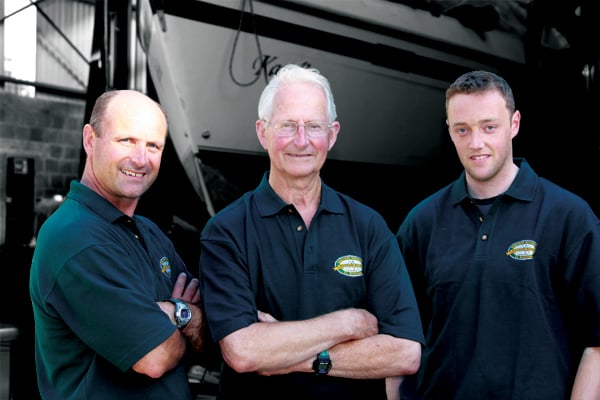
Graeme Noonan (left) has extensive big boat repair experience from his time in the marine industry in Sydney, Australia and is an active RS sailor. Founder Tony Noonan (centre) has spent a lifetime in the Irish Marine industry with Neil Watson Yachts, Wicklow Marine Services before setting up Noonan Boats in 1995. Brian Flahive is an active dinghy and keelboat sailor this year finished second in the Round Ireland double-handed class and won the Fireball National Championships.
Father and son team Tony and Graeme Noonan have over 30 years in the business and have recently expanded the premises to over 3,000 sq feet to cater for a growing range of repair work for boats up to 50 feet under cover.
They have a well-established reputation for the treatment of osmosis, to resolve hull blistering. This is a preventative and remedial process that requires specialist treatment.
The bulk of repair work comes from along the East Coast based boats and the nearby port of Dun Laoghaire but the company offers a national service to include transport to and from the Noonan boatyard if required.
“We have an established track record dealing with Insurance companies. No job is too difficult, too small or too big for us” says Tony Noonan.
Most work is carried out in in a purpose-built marine workshop containing two lifting bay facilities that includes keel and rudder repair pits but the firm also carries out on site repairs to suit too.
Repairs are carried out to original specifications and they carry out re-moulding repairs to up to date construction methods e.g. GRP foam core, Balsa core and carbon under vacuum bagging conditions.
A particular speciality is the repair of carbon repairs to dinghy masts, spinnaker poles and hulls. This has become more popular recently with the advent of carbon bowsprits on boats such as the J109s and SB3s.
Keel fairing, the process of improving the accuracy of the shape of a keel to improve boat speed is also high on the jobs list.
The company also has the specialist hot weld equipment to carry out the repair of polyethylene materials as used in the RS Feva and Laser Pico dinghies.
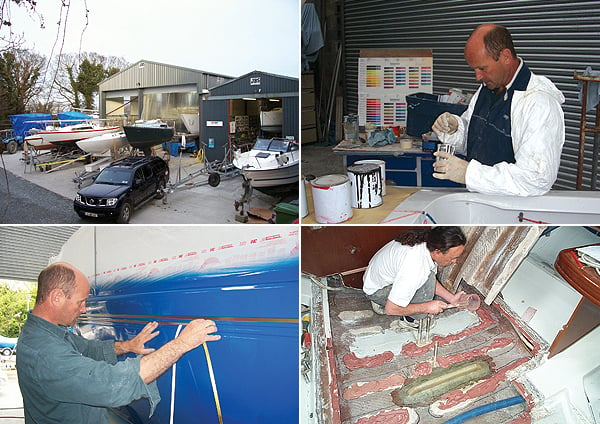
Colour Matching
Making a fibreglass repair to bring a boat back to original specification is one thing but matching gel coat to weathered or faded paintwork is quite another. Noonan Boatyard cosmetically match gels to present colour so the repair can appear practically invisible.
Polyethelene Repair
Plastic boats are durable but they can split and crack. Repairing them requires specialist heat gun welding equipment
Repair and re-spray
Weathered topsides, especially darker colours, always benefit from a re-spray, tired areas including decks and non-skid areas can also be re-sprayed
Floor matrix repair
After a keel grounding with rocks, for example, damage to a floor matrix may not be immediately visible but it is vital that inner frames are checked and repaired
Osmosis treatment, hot vac and copper coat
The yard uses the latest technology in the treatment of osmosis. Hulls are gel-planed to expose lay up prior to a HOT- VAC process and drying. This can be the stage where copper coat is an economical choice. It ends the need for the expensive and unpleasant annual chore of cleaning and repainting a boat’s hull. Simply hose down the hull at regular intervals, commonly once a year, to remove any build-up of sea-slime. We currently have two examples in our yard at present which show after one year and after ten years of immersion – and still working. Come and see for yourself!
Fully Repaired, Tried and Tested
Noonan Boats completed extensive repairs to Oystercatcher, a Gibsea 37, and when this work was completed the firm entered the boat in the gruelling 704-mile race round Ireland.
Local sailors Brian Flahive (Fireball National Champion) who works at the yard and Bryan Byrne manned what was Wicklow Sailing Club’s first ever yacht to entry into the doubled handed class of the Race. Dubbed the ‘Pride of Newcastle’ the entry finished an impressive winner of IRC III and Cruiser Class IV. The pair also finished second in the two handed class.
It was no easy journey but certainly the repairs stood up to the job, a case of repair work being tried, tested and proven!
The Boatyard, Sea Road, Newcastle, Greystones, Co. Wicklow
Tel/Fax: 01 281 9175 • Mobile: 086 170 8875
Email: [email protected]
- boats
- Wicklow
- RS Feva
- Dun Laoghaire
- Greystones
- collision
- Brian Flahive
- noonans boats
- wicklow boatyard
- boat repair
- keel fairing
- osmosis
- Newcastle
- Neil Watson
- Graeme Noonan
- Tony Noonan
- repair
- hull blistering
- Insurance
- lifting bay
- workshop
- GRP
- vacuum bagging
- carbon repairs
- dinghy masts
- spinnaker poles
- Laser Pico
- Polyethelene Repair
- respray
- Floor matrix
- hot vac
- copper coat
- Repaired
- damage
Concerns for Greystones Harbour Development
A report in today's Irish Times says there is concern over the Euro 300 Million redevelopment of Greystones harbour after the builders confirmed the project is to come under the control of Nama. Last week we posted details of the changes to the plans released by Cllr. Derek Mitchell HERE. The Irish Times report by Tim O'Brien HERE and in Oct/Nov Afloat magazine, on the shelves this week, WM Nixon describes his first landing in the new harbour in Afloat's regular Soundings Column. Attached for download (5mb) is 'Greystones Harbour and Marina presentation to Greystones Town Council' document detailing the next phase.
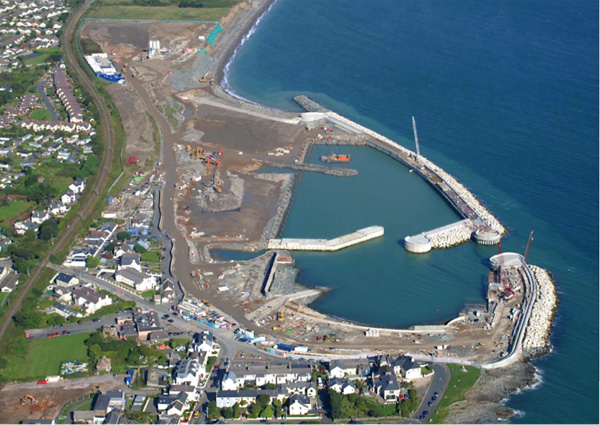
The new harbour takes shape in Greystones. Photo: courtesy Wicklow County Council
Aerial Photo Shows New Greystones Slipway
The new public slipway at the still under construction Greystones Harbour in Co. Wicklow is now operational and local clubs have been given access. It is now possible to launch three boats at one time even at low water (when most slips run out of water). The latest aerial photo of the site from July 23rd is published below showing the new slipway and the marina basin.
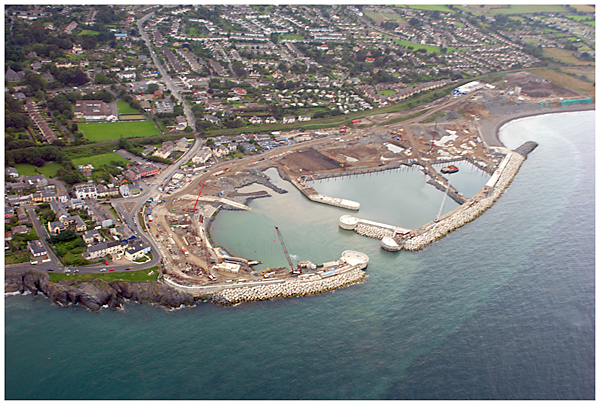
There has been good news in Wicklow for watersports fans with the new public slip opening at Greystones harbour. It is now possible to launch three boats at one time even at low water (when most slips run out of water), which is a great improvement. At the moment it is understood only limited access is available to the slip as building works are undergoing. When finished there will be a second wide slip and Cllr Derek Mitchell of the town council maintains the new facilities will be the best public boat launching facilities in the country.
Sispar, who are building the harbour, stated that the marine works are still on target to be completed this October and building a Medical centre on the site will start then provided Wicklow Council vote for it in September. Completion is expected late in 2011. It is hoped to build the Public Square, Clubhouses and take down the hoardings by the same time.
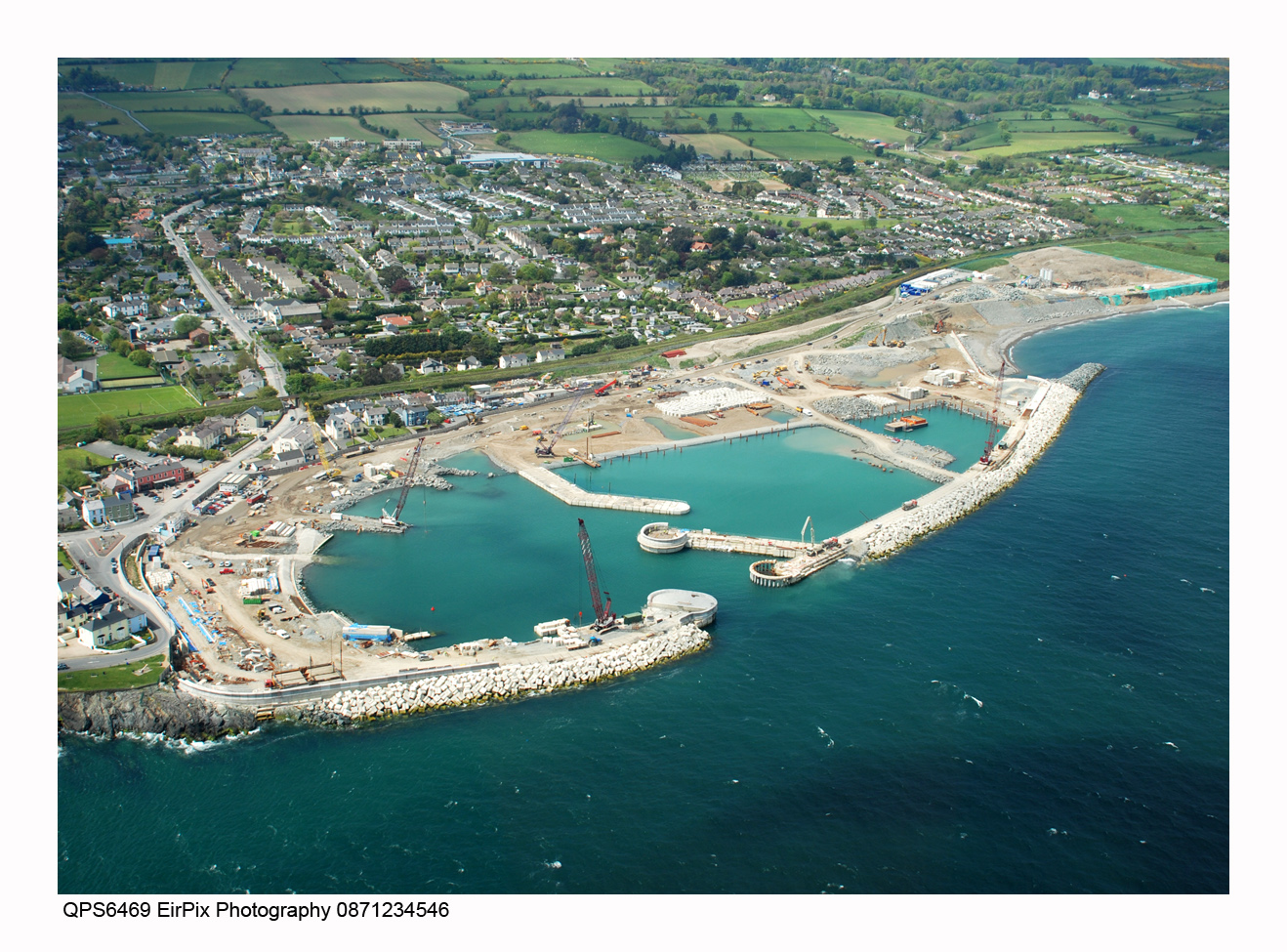
Greystones Marina under construction in June 2010
Because of this building it is unlikely that the planned 200 berth marina can open until early 2012 as land access will be across the building site. Sispar is keen to add up to 34 houses to the planning permission later and will consider this following Bord Pleanala’s ruling that moving some of the old town dump will require their approval. The problem being that Bord Pleanala’s approval process could take over a year.
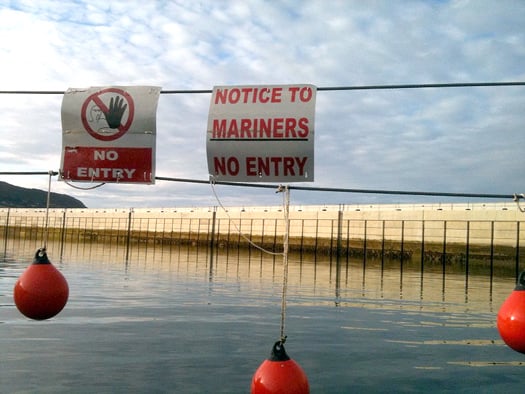
No entry to boaters in the marina basin
Cllr Mitchell has made a submission to the Planning process to ask that better drainage be provided in Darcy’s field to try to reduce erosion and that more boat storage and maintenance areas be provided to produce more jobs. "Also I have asked that the large Public Square be reorganised to provide more open continuous space for major town events such as concerts, parades, car shows etc" he told Afloat.ie
Greystones Sailing Club
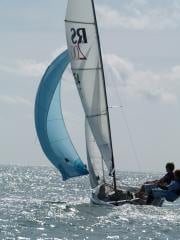 Left: Sunday Juniors at Greystones SC, 2009
Left: Sunday Juniors at Greystones SC, 2009
Founded in 1968, Greystones Sailing Club has established a reputation as one of the top dinghy sailing clubs in Ireland. Its sailors have competed successfully in many open events over the years, both nationally and internationally. With over 300 members sailing a variety of dinghy classes, Greystones Sailing Club offers exciting and enjoyable dinghy racing for all ages and abilities and looks forward to welcoming keel boat members when the harbour facilities in Greystones are upgraded.
The club has an active training and sailing program providing sailing instruction for about 100 local children and 30 adults every year with on going class specific training for other members. Powerboat, VHF, First-Aid and Sailing Instructor courses are also run on an ad-hoc basis and are open to non-members. GSC also offers St David's Secondary School transition year students introductory Sailing courses.
Greystones Sailing Club has played host to a number of prestigious sailing events at International, National and Regional levels. It has organised and run Championship events for the Mirror, Enterprise, GP14 and Wayfarer classes. Greystones has been at the forefront of modern dinghy racing, introducing the RS dinghy classes into Ireland and for three of the last five years, hosting one leg of the internationally renowned RS Eurocup circuit.
(The above information and image courtesy of Greystones Sailing Club)
Greystones Sailing Club, Club Secretary, North Beach, Greystones, Co. Wicklow. Email: [email protected]
Have we got your club details? Click here to get involved


























